Abstract
Brain-Computer Interface (BCI) is a technique that allows the disabled to interact with a computer directly from their brain. P300 Event-Related Potentials (ERP) of the brain have widely been used in several applications of the BCIs such as character spelling, word typing, wheelchair control for the disabled, neurorehabilitation, and smart home control. Most of the work done for smart home control relies on an image flashing paradigm where six images are flashed randomly, and the users can select one of the images to control an object of interest. The shortcoming of such a scheme is that the users have only six commands available in a smart home to control. This article presents a symbol-based P300-BCI paradigm for controlling home appliances. The proposed paradigm comprises of a 12-symbols, from which users can choose one to represent their desired command in a smart home. The proposed paradigm allows users to control multiple home appliances from signals generated by the brain. The proposed paradigm also allows the users to make phone calls in a smart home environment. We put our smart home control system to the test with ten healthy volunteers, and the findings show that the proposed system can effectively operate home appliances through BCI. Using the random forest classifier, our participants had an average accuracy of 92.25 percent in controlling the home devices. As compared to the previous studies on the smart home control BCIs, the proposed paradigm gives the users more degree of freedom, and the users are not only able to control several home appliances but also have an option to dial a phone number and make a call inside the smart home. The proposed symbols-based smart home paradigm, along with the option of making a phone call, can effectively be used for controlling home through signals of the brain, as demonstrated by the results.
1. Introduction
A neurological disease known as a locked-in syndrome is caused by the total paralysis of all voluntary muscles throughout the body. It could be caused by brain or spinal cord damage, amyotrophic lateral sclerosis, brainstem stroke, diseases of the circulatory system, damage to nerve cells, and several other neuromuscular diseases. People who have locked-in syndrome are completely cognizant and able to reason and think, but they are unable to talk or move anything other than their eyes. All other voluntary muscle movement is blocked, making it impossible for them to speak or move [1,2,3]. Locked-in syndrome patients may generally move their eyes and can occasionally blink to communicate, but some seriously ill patients can also lose control of their eye movements and may become completely paralyzed. It is extremely difficult to interact with individuals who have locked-in syndrome and other forms of paralysis since they are unable to speak or express their needs or sentiments to those around them due to their lack of muscle-based modes of communication. For such patients, a direct brain-computer interface (BCI), which sends messages and instructions to the outside world via a new, non-muscular communication and control channel, may be an effective option. These people may be able to communicate once again because of brain-computer interfaces that open a new line of communication between their brain signals and computers. Recent research has demonstrated that BCI technology makes it viable for the brain to directly interact with the outside world, enabling paralyzed people to interact and gain control. The BCI technology enables users to interact with computers and operate appliances without using their muscles. BCI research aims to improve the overall quality of life for the disabled by giving them access to technology that allows them to interact with their environment. To attain this objective, several BCI applications have been presented in the literature. including character spelling [4,5], word typing [6], controlling a wheelchair [7,8], controlling a robotic/prosthetic limb [9], virtual reality control [10,11], neurorehabilitation [12], controlling a car [13], web browser control [14], Unmanned Aerial Vehicle (UAV) control [15,16], and games [17,18,19]. All these BCIs take commands from the brain and transform them to control signals for the desired application.
There are numerous ways of reading the brain’s activity such as functional Magnetic Resonance Imaging (fMRI), Magnetoencephalography (MEG), Positron Emission Tomography (PET), Computer Tomography (CT), Electrocorticography (ECoG), and functional Near-Infrared Spectroscopy (fNIRS). However, Electroencephalography (EEG) has been the most popular type for BCIs because it is non-invasive, relatively cheap, and easier to use. The brain’s EEG signal is made up of numerous signals with varied characteristics, each of which corresponds to a different mental activity. P300 Event-Related Potential (ERP), one of the signals, has been used in various BCI applications. When the user is exposed to an uncommon stimulus in a sequence of common stimuli, about 300 milliseconds after the start of the target/rare stimulus, a positive wave called P300 appears. It is induced when a person recognizes an occasional “target” stimulus among a regular stream of common “non-target” stimuli. When the user concentrates on a specific stimulus while simultaneously being exposed to several stimuli, P300 can be induced. In 1998, Farwell and Donchin [20] were the first to demonstrate a character spelling application of the P300-ERP. They proposed displaying a flashing matrix, having 6 rows and 6 columns of characters and numbers, to the users, and taking EEG signals of the users. They could get the P300 wave only after the target character was flashed, which could be detected using a classifier. The P300 signal has been used for numerous other applications of BCI; for instance, directing the movement of a cursor or a screen item [21,22], browsing the internet [23], file explorer [24], Playing games [25], and navigating a wheelchair [26].
There have been few studies on using the BCI to operate a smart-home environment. Hoffmann et al. [27] proposed an interface consisting of 6 images of home appliances for disabled subjects, and the users could select one of the images. Their proposed image flashing paradigm had been the most popular paradigm for smart-home control and several researchers used the same scheme. Achanccaray et al. [28] and Cortez et al. [29] used the same paradigm to control six home appliances. The problem with this image flashing paradigm is that the users have only six commands available, therefore they can perform only six tasks in a smart home. Carabalona et al. [30] developed an icon-based smart home control system. They proposed to use icons instead of characters in a smart home control system. However, the accuracy achieved using their proposed system was very low i.e., 50%. Park et al. [31] used Steady-State Visual Evoked Potentials (SSVEP) to operate three household appliances: a robotic vacuum cleaner, an air cleaner, and a humidifier. Kais et al. [32] proposed an implementation of home devices control using the motor imagery BCI. They used the BCI competition dataset where subjects performed four types of motor imagery (Left hand, Right hand, Foot, and Tongue). These four motor imagery states can be used to turn on/off two devices. Edlinger et al. [33] combined P300 and SSVEP for controlling a virtual home environment and tested their system with three subjects. Katyal et al. [34] also proposed a hybrid paradigm containing SSVEP and P300 to increase the number of decision options. Similarly, Chai et al. [35] proposed combining SSVEP with electromyography (EMG) signals. Uyanik et al. [36] proposed an SSVEP-based BCI to control a wheelchair along with a smart home. Kim et al. [37] combined ERPs with speech imagery. Usman et al. [38], proposed a symbols-based smart home control system using the P300. The suggested method used a 6×4 matrix, akin to the character spelling paradigm. The proposed system was tested on three subjects and achieved an accuracy of 87.5%. Taejun Lee et al. [39] utilized a BCI based on the P300 to control three home applications: the door lock, the electric light, and the speaker. Vega et al. [40] used six symbols of commonly used home appliances and employed a deep learning model for the classification of EEG. Shukla et al. [41,42] used a 2 × 3 matrix containing six symbols (TV, Mobile, Door, Fan, Light bulb, and Heater) and used P300-ERP to control these six appliances. They tested their system with 14 participants and achieved an average accuracy of 92.44%. The problem with such systems is the limited number of control options available to the users.
This paper proposes a P300-based intelligent home control system that allows users to control multiple home appliances and allows them to dial a phone call. Our interface comprises a matrix of twelve symbols. Each symbol indicates a smart home activity that can be executed. Users can choose any symbol to perform their desired action, such as turning on or off lights. To detect P300, we employed a supervised machine learning algorithm, Random Forest (RF), and evaluated our proposed system with 10 healthy participants for smart home control and making phone calls. The accuracy rate was 92.25 percent on average.
2. Materials and Methods
Our methodology comprises displaying a flashing paradigm to the user as shown in Figure 1. While the user is observing the flashing paradigm, EEG waves are recorded using a 32-channel EEG cap. After preprocessing, a random forest classifier is then used to classify the P300 signal of the brain. The classification of the P300 signal leads to choosing the target symbol. Ideally, the P300 should be found after 300 ms of the flashing of the symbol the user is focusing on.
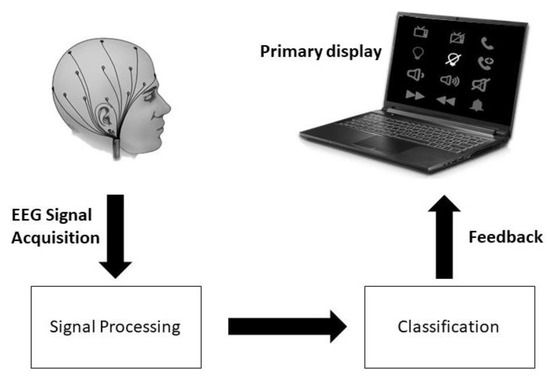
Figure 1.
Block diagram of the proposed system.
2.1. Participants
Ten healthy volunteers (7 males and 3 females; ages 18 to 35 years) participated in the experiments. The participants’ vision was normal or corrected and had no record of any neurological brain illnesses. None of the participants had any prior knowledge or experience with BCIs of any kind. The experimental protocol was explained to the participants and all participants signed a written informed consent form before the start of the experiment.
2.2. Primary Display for Controlling Home Appliances
In this paper, we propose an interface that consists of a 4 × 3 matrix containing 12 symbols. Each symbol is randomly intensified as shown in Figure 2, and the users must concentrate on the symbol they want to choose. The description of those symbols is shown in Figure 3. Rather than intensifying rows and columns of the matrix as in traditional P300 displays, we chose to intensify each symbol individually because previous research has shown that the prior probability of the target is inversely related to the amplitude of the P300 [43]. Higher probabilities of the appearance of the target lead to lower amplitudes of the P300-ERP, which in turn makes the classification difficult and hence reduces accuracy. In the case of our proposed smart home control, we have only 12 symbols in the main display making it a 4 × 3 matrix. Using the row and column-wise intensification will lead us to have a target probability of 2/7 because out of seven intensifications (4 rows and 3 columns) two should contain the target symbol (one row and one column). Whereas intensifying each symbol gives us the probability of the appearance of the target symbol to be 1/12 which is far less than the row/column intensification.
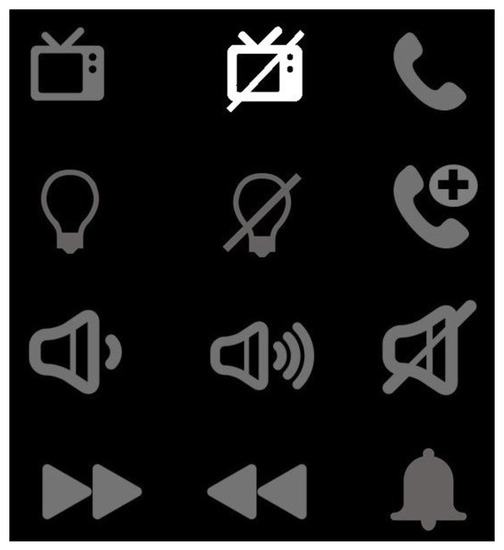
Figure 2.
Primary Display to control the smart home.
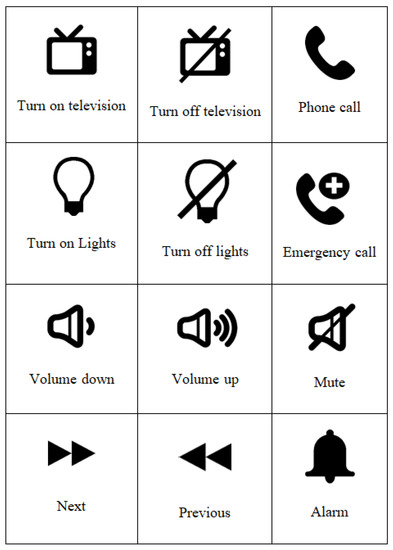
Figure 3.
Functional symbols on the main Interface and their description.
The subjects were told to randomly choose a symbol and focus on the chosen symbol and count how many times it flashed quietly. After 300 ms of the target symbol flashing, P300 appears. Intensifications are randomized in blocks. Each symbol is intensified exactly once in random order in each block of twelve intensifications. This intensification block is repeated fifteen times in total. We employed a 100 ms intensification time with a 75 ms blank interval in between.
On the primary display, the users have twelve symbols to choose from, and each symbol represents an action to be taken in the smart home such as controlling the TV, lights, volume, and phone. The description of all those symbols is shown in Figure 3.
2.3. Secondary Display for Making Phone Calls
In our proposed system, the users have the option of making phone calls along with controlling the home appliances. On the main display, there is a symbol for a phone call as shown in Figure 2 and Figure 3. If the user selects that phone call symbol, the display gets changed to a secondary display containing a 4 × 3 matrix of numbers that are shown in Figure 4. The secondary display contains numbers (0–9) for typing the phone number to be called, a call symbol for connecting the phone call, and a return symbol to disconnect the phone call and return to the primary display.
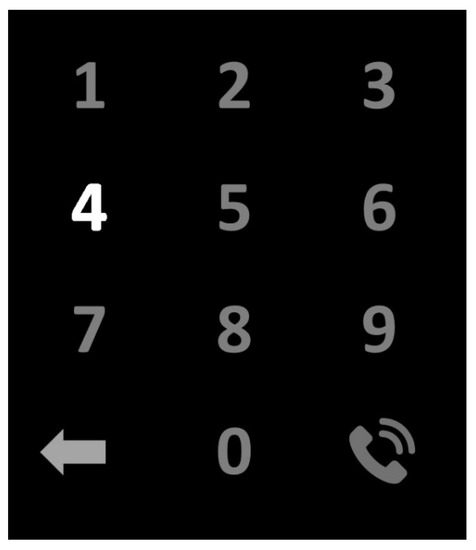
Figure 4.
Secondary display for making phone calls.
2.4. Experimental Setup
A 32-channel EEG data was acquired, as per the 10–20 international electrode system. The placement of electrodes is shown in Figure 5. Out of those 32 channels, only 8 were used for the classification of ERPs. The subjects were seated on a cozy chair in front of a display screen and were instructed to focus on the desired symbol from the displayed symbols (as shown in Figure 2). Each participant was required to attend two sessions: training and testing. Each participant was instructed to select a random symbol/number during the training session, and this experiment was repeated 10 times. During the test session, each participant chose 40 symbols/numbers at random (20 symbols on the main display and 20 numbers on the secondary display).
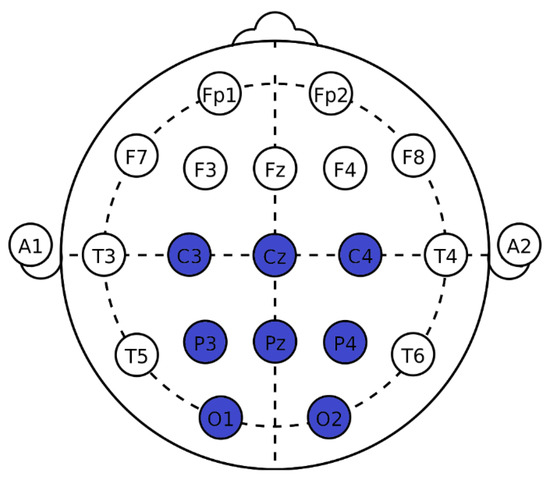
Figure 5.
Electrode placement (highlighted electrodes are used in this study).
2.5. Signal Processing and Classification
In this study, we used 8 channels for signal processing and classification. The locations of the used electrodes are shown in Figure 5. It is known from the previous studies [44,45] that the P300-ERP is most dominant in the Pz area and the nearby electrodes. Therefore, we have chosen only those locations. The acquired EEG signals are bandpass filtered using a third-order Butterworth filter between 0.1 Hz to 25 Hz to remove the noise. The filtered signal is then segmented, and segments of 800 ms are extracted after the onset of each stimulus, i.e., flashing of each symbol from each of the used channels. To construct a single feature vector, the data segments are concatenated over the eight channels.
For the classification of P300-ERPs, we employed the random forest classifier because RF had shown superior performance in P300 classification in our previous studies [38,46]. We also compared the results of the random forest classifier with commonly used classification methods such as Support Vector Machine (SVM), Linear Discriminant Analysis (LDA), and k-nearest neighbors (kNN).
Random Forest is an ensemble classification technique. The general idea of the random forest is to build multiple decision tree classifiers and combine their results for better accuracy. Using multiple classifiers in an ensemble gives a more stable prediction. Random forest utilizes a random subset of the data to train each of the decision trees in the forest and then combines the result of each decision tree by majority voting. In this way, the weak classifiers are combined to form a strong classifier.
Random Forest was used to detect the presence of P300 ERPs in the recorded EEG signal. The system selects the symbol that elicits P300-ERP and displays the result as feedback to the user.
3. Results
We conducted experiments using our proposed paradigm on ten healthy volunteers. The 32 channels’ EEG data was acquired at a sampling frequency of 250 Hz. The participants were instructed to pay close attention to the target symbol and silently count how many times it flashed. This silent counting helps users in maintaining their attention. Each participant attended two sessions, namely training, and testing. During training, each participant selected 10 randomly selected symbols and during the test session, 40 symbols/numbers were selected, one at a time, as per the choice of the participants. The users were shown the main display, as shown in Figure 2. The symbols on the display were randomly flashing. The flashing time is shown in Table 1.

Table 1.
Flashing time of the proposed paradigm.
Flashing a single symbol takes 175 ms: 100 ms for flashing and 75 ms of blank time in between two flashes. The proposed paradigm has a total of 12 symbols on the screen. Therefore, to flash each symbol once, the system requires 2.1 s. We had chosen to flash each symbol 15 times. Therefore, if we calculate the time required to select a symbol by each user, it comes out to be 31.5 s (2.1 × 15). The same timings were used in the second (numbers-based) paradigm to make a phone call. The users can select each number in 31.5 s. Figure 6 shows the images of the data collection.
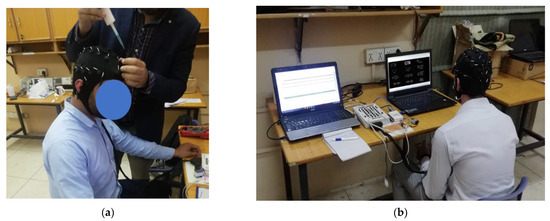
Figure 6.
Data Collection. (a) Preparation for EEG data collection; (b) A participant during data collection.
3.1. Experimental Results
During the test session, each user was asked to select twenty random symbols on the primary symbols-based display, and twenty random numbers on the phone call interface. Table 2 presents the accuracy of classification for each subject on both displays. The random forest classifier achieved an overall accuracy of 92.25 percent.

Table 2.
Classification accuracies on the proposed displays using random forest classifier.
We also compared the results of the random forest classifier with other commonly used classifiers such as SVM, LDA, kNN. The comparison of the accuracies obtained by these classifiers is presented in Table 3. All these classifiers performed well with minor differences in accuracies. RF classifier performed the best with an average accuracy of 92.25, whereas the SVM, LDA, and kNN achieved average classification accuracies of 91, 89.25, and 90.25 percent, respectively.

Table 3.
Comparison of classification accuracies using RF, SVM, LDA, and kNN classifiers.
3.2. Waveform Morphologies
The averaged ERPs for target and non-target stimuli are shown in Figure 7 for both the proposed displays. The P300 event-related potential is visible for the target cases in both paradigms. However, it was noted that the amplitude of the P300 was smaller in the case of the symbols-based paradigm. The accuracy was also lesser in the case of the symbols-based paradigm as shown in Table 2.
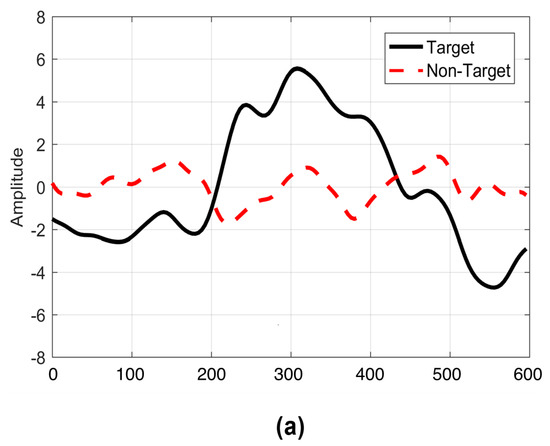

Figure 7.
Waveforms for target and non−target stimuli. (a) Primary symbols−based display for controlling home appliances. (b) Secondary display (Numbers−based) for making phone calls.
A comparison of the P300 waveforms for the primary and secondary paradigms is shown in Figure 8. The amplitude of the numbers-based paradigm is larger than the symbols-based paradigm. The reason for this difference in P300 amplitude can be the familiarity of the users with numbers. The users are more familiar with the numbers, as compared to the symbols. This familiarity improves the user’s P300 response, which leads to improved classification accuracy. The comparison of accuracies on both the paradigms is presented in Figure 9.
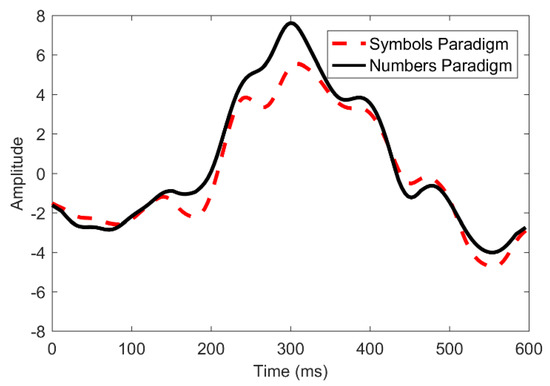
Figure 8.
Comparison of the ERPs for both the displays.
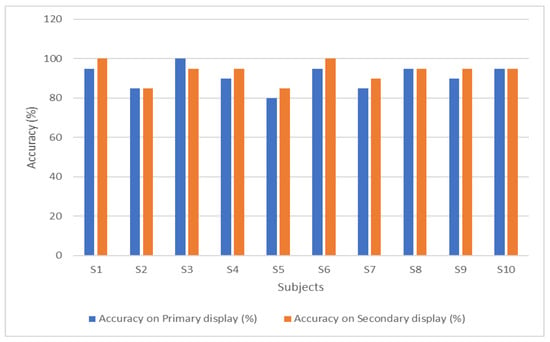
Figure 9.
Comparison of the classification accuracies for both the displays.
A slight difference in accuracies of the primary and secondary display can be seen in Figure 9, because the amplitude of P300-ERPs was smaller in the case of the symbols-based paradigm. The numbers-based paradigm produced better P300 however, the difference is not that significant. On average, the numbers-based paradigm has 2.5% better accuracy than the symbols-based paradigm.
4. Discussion and Conclusions
This paper presented a novel BCI paradigm to control home appliances using the P300-ERP of the brain. The proposed paradigm included common household appliances such as televisions, lights, and music. We also included an option to make a phone call in our smart home. As evident from the results, the proposed P300-BCI system is capable of both controlling appliances and making phone calls in a smart home setting.
Compared to our previously proposed smart home system [38], we have achieved better accuracy in this paper. The reason for this improvement in accuracy is a single symbol flashing instead of flashing rows and columns. When we do rows/columns flashing in a 4 × 3 matrix, there are a total of 7 flashes (4 rows and 3 columns). Out of these seven flashes, two flashes correspond to the target symbol/number (one row and one column). This leads the prior probability of the target to be 2/7 or 0.286. Whereas flashing individual numbers/symbols in the same 4 × 3 matrix gives us a prior probability of target as 1/12 or 0.083 (one symbol out of a total twelve). It is known from previous studies [43] that in an oddball paradigm, the P300’s magnitude is negatively correlated with the target’s prior probability. The probability of flashing the target symbol is very low in this proposed paradigm as compared to the previous studies. Therefore, it leads to better P300 s, which in turn gives us better classification accuracy. Moreover, we have included a secondary paradigm for making phone calls and the users were able to dial phone numbers with an accuracy of 93.5%.
We can see from the results that the accuracy of the secondary display (numbers-based) is slightly better than the symbols-based display, one reason for this can be the familiarity of the users with the numbers as compared to the symbols. These results are consistent with Kaufmann et al. [47] where they had replaced the characters with the popular faces in a P300-based paradigm and achieved better accuracies.
Compared with the other smart home applications proposed in the literature, the proposed paradigm offers a more degree of freedom with an increased number of devices to control. The users can control 12 devices at a time using a single interface. The users also have the freedom to dial a phone number of their choice and make a phone call, which is an important aspect in improving the quality of life of the disabled. The number of symbols can further be increased and can be changed depending on the application and requirements of the users.
We have calculated the time required by the users to perform each command in the smart home. The users require 31.5 s to perform each command (selecting a symbol or a number). The time can be reduced by reducing the number of repetitions in flashing. However, if we reduce the number of flashes, the classification of P300 s gets difficult and may decrease the classification accuracy. In the future, better classification models can be employed to solve this problem of P300 recognition in a lesser number of repetitions.
Author Contributions
Conceptualization, F.A. and U.M.; Methodology, F.A. and U.M.; Software, F.A., A.A. and M.A.; Validation, A.A., M.A. and M.H.; Formal analysis, F.A. and U.M.; Data curation, F.A., A.A., M.A. and M.H.; Investigation, F.A. and U.M.; Resources, A.A., M.A. and M.H.; Writing—original draft preparation, F.A. and U.M.; writing—review and editing, F.A., A.A., M.A., M.H. and U.M.; Supervision, F.A.; Project Administration, U.M.; Funding Acquisition, A.A., M.A. and M.H. All authors have read and agreed to the published version of the manuscript.
Funding
This research received no external funding.
Institutional Review Board Statement
The study was conducted in accordance with the Declaration of Helsinki and approved by the Research Ethics Committee of Riphah International University.
Informed Consent Statement
Informed consent was obtained from all subjects involved in the study.
Conflicts of Interest
The authors declare no conflict of interest.
Abbreviations
The following abbreviations are used in this manuscript:
| BCI | Brain-Computer Interface |
| CT | Computer Tomography |
| ECoG | Electrocorticography |
| EEG | Electroencephalography |
| EMG | Electromyography |
| ERP | Event Related Potential |
| fMRI | functional Magnetic Resonance Imaging |
| fNIRS | functional near-infrared spectroscopy |
| kNN | k-Nearest Neighbors |
| LDA | Linear Discriminant Analysis |
| MEG | Magnetoencephalography |
| PET | Positron Emission Tomography |
| RF | Random Forest |
| SSVEP | Steady-State Visual Evoked Potentials |
| SVM | Support Vector Machine |
References
- Laureys, S.; Pellas, F.; van Eeckhout, P.; Ghorbel, S.; Schnakers, C.; Perrin, F.; Berré, J.; Faymonville, M.E.; Pantke, K.H.; Damas, F.; et al. The Locked-in Syndrome: What Is It like to Be Conscious but Paralyzed and Voiceless? Prog. Brain Res. 2005, 150, 495–611. [Google Scholar] [CrossRef] [PubMed]
- Smith, E.; Delargy, M. Locked-in Syndrome. BMJ 2005, 330, 406–409. [Google Scholar] [CrossRef] [PubMed]
- Lulé, D.; Zickler, C.; Häcker, S.; Bruno, M.A.; Demertzi, A.; Pellas, F.; Laureys, S.; Kübler, A. Life Can Be Worth Living in Locked-in Syndrome. Prog. Brain Res. 2009, 177, 339–351. [Google Scholar] [CrossRef] [PubMed]
- Kaufmann, T.; Völker, S.; Gunesch, L.; Kübler, A. Spelling Is Just a Click Away—A User-Centered Brain-Computer Interface Including Auto-Calibration and Predictive Text Entry. Front. Neurosci. 2012, 6, 72. [Google Scholar] [CrossRef]
- Kübler, A.; Furdea, A.; Halder, S.; Hammer, E.M.; Nijboer, F.; Kotchoubey, B. A Brain-Computer Interface Controlled Auditory Event-Related Potential (P300) Spelling System for Locked-In Patients. Ann. N. Y. Acad. Sci. 2009, 1157, 90–100. [Google Scholar] [CrossRef]
- Akram, F.; Han, H.S.; Kim, T.S. A P300-Based Brain Computer Interface System for Words Typing. Comput. Biol. Med. 2014, 45, 118–125. [Google Scholar] [CrossRef]
- Zgallai, W.; Brown, J.T.; Ibrahim, A.; Mahmood, F.; Mohammad, K.; Khalfan, M.; Mohammed, M.; Salem, M.; Hamood, N. Deep Learning AI Application to an EEG Driven BCI Smart Wheelchair. In Proceedings of the 2019 Advances in Science and Engineering Technology International Conferences, ASET 2019, Dubai, United Arab Emirates, 26 March–10 April 2019; Institute of Electrical and Electronics Engineers Inc.: Piscataway, NJ, USA, 2019. [Google Scholar]
- Sakkalis, V.; Krana, M.; Farmaki, C.; Bourazanis, C.; Gaitatzis, D.; Pediaditis, M. Augmented Reality Driven Steady-State Visual Evoked Potentials for Wheelchair Navigation. IEEE Trans. Neural Syst. Rehabil. Eng. 2022, 30, 2960–2969. [Google Scholar] [CrossRef]
- McFarland, D.J.; Wolpaw, J.R. Brain-Computer Interface Operation of Robotic and Prosthetic Devices. Computer 2008, 41, 52–56. [Google Scholar] [CrossRef]
- Heo, D.; Kim, M.; Kim, J.; Choi, Y.J.; Kim, S.-P. The Uses of Brain-Computer Interface in Different Postures to Application in Real Life. In Proceedings of the 10th International Winter Conference on Brain-Computer Interface (BCI), Gangwon-do, Republic of Korea, 21–23 February 2022; Institute of Electrical and Electronics Engineers (IEEE): Piscataway, NJ, USA, 2022; pp. 1–5. [Google Scholar]
- Coogan, C.G.; He, B. Brain-Computer Interface Control in a Virtual Reality Environment and Applications for the Internet of Things. IEEE Access 2018, 6, 10840–10849. [Google Scholar] [CrossRef]
- Khan, M.A.; Das, R.; Iversen, H.K.; Puthusserypady, S. Review on Motor Imagery Based BCI Systems for Upper Limb Post-Stroke Neurorehabilitation: From Designing to Application. Comput. Biol. Med. 2020, 123, 103843. [Google Scholar] [CrossRef]
- Yu, Y.; Zhou, Z.; Yin, E.; Jiang, J.; Tang, J.; Liu, Y.; Hu, D. Toward Brain-Actuated Car Applications: Self-Paced Control with a Motor Imagery-Based Brain-Computer Interface. Comput. Biol. Med. 2016, 77, 148–155. [Google Scholar] [CrossRef] [PubMed]
- Gannouni, S.; Alangari, N.; Mathkour, H.; Aboalsamh, H.; Belwafi, K. BCWB: A P300 Brain-Controlled Web Browser. Int. J. Semant. Web Inf. Syst. 2017, 13, 55–73. [Google Scholar] [CrossRef]
- Prasath, M.S.; Naveen, R.; Sivaraj, G. Mind-Controlled Unmanned Aerial Vehicle (UAV) Using Brain–Computer Interface (BCI). Unmanned Aer. Veh. Internet Things 2021, 13, 231–246. [Google Scholar] [CrossRef]
- Masud, U.; Saeed, T.; Akram, F.; Malaikah, H.; Akbar, A. Unmanned Aerial Vehicle for Laser Based Biomedical Sensor Development and Examination of Device Trajectory. Sensors 2022, 22, 3413. [Google Scholar] [CrossRef] [PubMed]
- Li, M.; Li, F.; Pan, J.; Zhang, D.; Zhao, S.; Li, J.; Wang, F. The MindGomoku: An Online P300 BCI Game Based on Bayesian Deep Learning. Sensors 2021, 21, 1613. [Google Scholar] [CrossRef] [PubMed]
- Dutta, S.; Banerjee, T.; Roy, N.D.; Chowdhury, B.; Biswas, A. Development of a BCI-Based Gaming Application to Enhance Cognitive Control in Psychiatric Disorders. Innov. Syst. Softw. Eng. 2021, 17, 99–107. [Google Scholar] [CrossRef]
- Louis, J.D.; Alikhademi, K.; Joseph, R.; Gilbert, J.E. Mind Games: A Web-Based Multiplayer Brain-Computer Interface Game. Proc. Hum. Factors Ergon. Soc. Annu. Meet. 2022, 66, 2234–2238. [Google Scholar] [CrossRef]
- Farwell, L.A.; Donchin, E. Talking off the Top of Your Head: Toward a Mental Prosthesis Utilizing Event-Related Brain Potentials. Electroencephalogr. Clin. Neurophysiol. 1988, 70, 510–523. [Google Scholar] [CrossRef]
- Piccione, F.; Giorgi, F.; Tonin, P.; Priftis, K.; Giove, S.; Silvoni, S.; Palmas, G.; Beverina, F. P300-Based Brain Computer Interface: Reliability and Performance in Healthy and Paralysed Participants. Clin. Neurophysiol. 2006, 117, 531–537. [Google Scholar] [CrossRef]
- Citi, L.; Poli, R.; Cinel, C.; Sepulveda, F. P300-Based BCI Mouse with Genetically-Optimized Analogue Control. IEEE Trans. Neural Syst. Rehabil. Eng. 2008, 16, 51–61. [Google Scholar] [CrossRef]
- Martínez-Cagigal, V.; Santamaría-Vázquez, E.; Gomez-Pilar, J.; Hornero, R. A Brain–Computer Interface Web Browser for Multiple Sclerosis Patients. Neurol. Disord. Imaging Phys. Vol. 2 Eng. Clin. Perspect. Mult. Scler. 2019, 2, 327–357. [Google Scholar] [CrossRef]
- Bai, L.; Yu, T.; Li, Y. A Brain Computer Interface-Based Explorer. J. Neurosci. Methods 2015, 244, 2–7. [Google Scholar] [CrossRef] [PubMed]
- Finke, A.; Lenhardt, A.; Ritter, H. The MindGame: A P300-Based Brain-Computer Interface Game. Neural. Netw. 2009, 22, 1329–1333. [Google Scholar] [CrossRef] [PubMed]
- Eidel, M.; Kübler, A. Wheelchair Control in a Virtual Environment by Healthy Participants Using a P300-BCI Based on Tactile Stimulation: Training Effects and Usability. Front. Hum. Neurosci. 2020, 14, 265. [Google Scholar] [CrossRef] [PubMed]
- Hoffmann, U.; Vesin, J.-M.; Ebrahimi, T.; Diserens, K. An Efficient P300-Based Brain-Computer Interface for Disabled Subjects. J. Neurosci. Methods 2008, 167, 115–125. [Google Scholar] [CrossRef] [PubMed]
- Achanccaray, D.; Flores, C.; Fonseca, C.; Andreu-Perez, J. A P300-Based Brain Computer Interface for Smart Home Interaction through an ANFIS Ensemble. In Proceedings of the IEEE International Conference on Fuzzy Systems, Naples, Italy, 9–12 July 2017; Institute of Electrical and Electronics Engineers Inc.: Piscataway, NJ, USA, 2017. [Google Scholar]
- Cortez, S.A.; Flores, C.; Andreu-Perez, J. A Smart Home Control Prototype Using a P300-Based Brain–Computer Interface for Post-Stroke Patients. In Proceedings of the 5th Brazilian Technology Symposium. Smart Innovation, Systems and Technologies; Springer Science and Business Media Deutschland GmbH: Cham, Switzerland, 2021; Volume 202, pp. 131–139. [Google Scholar] [CrossRef]
- Carabalona, R.; Grossi, F.; Tessadri, A.; Castiglioni, P.; Caracciolo, A.; de Munari, I. Light on! Real World Evaluation of a P300-Based Brain-Computer Interface (BCI) for Environment Control in a Smart Home. Ergonomics 2012, 55, 552–563. [Google Scholar] [CrossRef]
- Park, S.; Cha, H.S.; Kwon, J.; Kim, H.; Im, C.H. Development of an Online Home Appliance Control System Using Augmented Reality and an SSVEP-Based Brain-Computer Interface. In Proceedings of the 8th International Winter Conference on Brain-Computer Interface, BCI 2020, Gangwon-do, Republic of Korea, 26–28 February 2020; Institute of Electrical and Electronics Engineers Inc.: Piscataway, NJ, USA, 2020. [Google Scholar]
- Kais, B.; Ghaffari, F.; Romain, O.; Djemal, R. An Embedded Implementation of Home Devices Control System Based on Brain Computer Interface. Proc. Int. Conf. Microelectron. ICM 2014, 2015, 140–143. [Google Scholar] [CrossRef]
- Edlinger, G.; Holzner, C.; Guger, C. A Hybrid Brain-Computer Interface for Smart Home Control. In Proceedings of the International Conference on Human-Computer Interaction, Orlando, FL, USA, 9–14 July 2011; Springer: Berlin/Heidelberg, Germany, 2011; pp. 417–426. [Google Scholar]
- Katyal, A.; Singla, R. A Novel Hybrid Paradigm Based on Steady State Visually Evoked Potential & P300 to Enhance Information Transfer Rate. Biomed. Signal Process. Control 2020, 59, 101884. [Google Scholar] [CrossRef]
- Chai, X.; Zhang, Z.; Guan, K.; Lu, Y.; Liu, G.; Zhang, T.; Niu, H. A Hybrid BCI-Controlled Smart Home System Combining SSVEP and EMG for Individuals with Paralysis. Biomed. Signal Process. Control 2020, 56, 101687. [Google Scholar] [CrossRef]
- Uyanik, C.; Khan, M.A.; Das, R.; Hansen, J.P.; Puthusserypady, S. Brainy Home: A Virtual Smart Home and Wheelchair Control Application Powered by Brain Computer Interface. Biodevices 2022, 1, 134–141. [Google Scholar] [CrossRef]
- Kim, H.J.; Lee, M.H.; Lee, M. A BCI Based Smart Home System Combined with Event-Related Potentials and Speech Imagery Task. In Proceedings of the 2020 8th International Winter Conference on Brain-Computer Interface (BCI), Gangwon-do, Republic of Korea, 26–28 February 2020. [Google Scholar] [CrossRef]
- Masud, U.; Baig, M.I.; Akram, F.; Kim, T.-S. A P300 Brain Computer Interface Based Intelligent Home Control System Using a Random Forest Classifier. In Proceedings of the 2017 IEEE Symposium Series on Computational Intelligence, Honolulu, HI, USA, 27 November–1 December 2017; Volume 2018. [Google Scholar]
- Lee, T.; Kim, M.; Kim, S.-P. Improvement of P300-Based Brain–Computer Interfaces for Home Appliances Control by Data Balancing Techniques. Sensors 2020, 20, 5576. [Google Scholar] [CrossRef] [PubMed]
- Vega, C.F.; Quevedo, J.; Escandón, E.; Kiani, M.; Ding, W.; Andreu-Perez, J. Fuzzy Temporal Convolutional Neural Networks in P300-Based Brain–Computer Interface for Smart Home Interaction. Appl. Soft Comput. 2022, 117, 108359. [Google Scholar] [CrossRef]
- Shukla, P.K.; Chaurasiya, R.K.; Verma, S.; Sinha, G.R. A Thresholding-Free State Detection Approach for Home Appliance Control Using P300-Based BCI. IEEE Sens. J. 2021, 21, 16927–16936. [Google Scholar] [CrossRef]
- Shukla, P.K.; Chaurasiya, R.K.; Verma, S. Performance Improvement of P300-Based Home Appliances Control Classification Using Convolution Neural Network. Biomed. Signal Process. Control 2021, 63, 102220. [Google Scholar] [CrossRef]
- Allison, B.Z.; Pineda, J.A. ERPs Evoked by Different Matrix Sizes: Implications for a Brain Computer Interface (BCI) System. IEEE Trans. Neural Syst. Rehabil. Eng. 2003, 11, 110–113. [Google Scholar] [CrossRef]
- Linden, D.E.J. The P300: Where in the Brain Is It Produced and What Does It Tell Us? Neuroscientist 2016, 11, 563–576. [Google Scholar] [CrossRef]
- Bledowski, C.; Prvulovic, D.; Hoechstetter, K.; Scherg, M.; Wibral, M.; Goebel, R.; Linden, D.E.J. Localizing P300 Generators in Visual Target and Distractor Processing: A Combined Event-Related Potential and Functional Magnetic Resonance Imaging Study. J. Neurosci. 2004, 24, 9353–9360. [Google Scholar] [CrossRef]
- Akram, F.; Han, S.M.; Kim, T.-S. An Efficient Word Typing P300-BCI System Using a Modified T9 Interface and Random Forest Classifier. Comput. Biol. Med. 2015, 56, 30–36. [Google Scholar] [CrossRef]
- Kaufmann, T.; Schulz, S.M.; Grünzinger, C.; Kübler, A. Flashing Characters with Famous Faces Improves ERP-Based Brain-Computer Interface Performance. J. Neural. Eng. 2011, 8, 56016. [Google Scholar] [CrossRef]
Publisher’s Note: MDPI stays neutral with regard to jurisdictional claims in published maps and institutional affiliations. |
© 2022 by the authors. Licensee MDPI, Basel, Switzerland. This article is an open access article distributed under the terms and conditions of the Creative Commons Attribution (CC BY) license (https://creativecommons.org/licenses/by/4.0/).